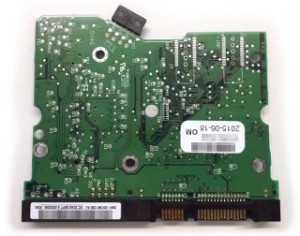 Your hard drive’s malfunctioning, and you’re pretty sure it’s an issue with the electronics. Can you simply swap out the Printed Circuit Board (PCB) with an identical model?
Your hard drive’s malfunctioning, and you’re pretty sure it’s an issue with the electronics. Can you simply swap out the Printed Circuit Board (PCB) with an identical model?
No, for several reasons. First and foremost, finding a truly identical replacement may be impossible; secondly, a PCB swap can introduce serious issues that can lead to permanent data loss.
Below, we’ll explain the relationship between the PCB and the hard drive’s firmware. We’ll also explain how professional data recovery laboratories address PCB issues.
Hard Drive PCBs Contain More Than Generic Circuitry
Modern hard drives contain a ROM chip, which contains adaptive parameters written at the factory and during operation. This data allows for operating compensations for various factors unique to the specific drive. That might include the drive’s firmware version and the precise positioning of the read/write heads.
This wasn’t the case in the late 1990s — in those days, a PCB swap could conceivably allow for data recovery (provided that the drive failed due to an electronic issue).
But on a modern hard drive, you’ll need to perfectly match the donor PCB to the recipient, and migrate that ROM chip or its data. You may also need to adjust the firmware (the drive’s operating instructions), which is only possible with specialized equipment.
These are techniques that our engineers use every day to restore data. However, rewriting firmware and swapping chips isn’t easy — and without specialized equipment and a working knowledge of hard drive architecture, it’s potentially dangerous.
What happens if you replace a hard drive’s PCB with a bad donor?
When you swap a PCB, the replacement PCB’s firmware is unlikely to understand the original drive’s unique adaptive parameters — even if it’s from a seemingly identical drive.
The drive heads, guided by the new PCB’s firmware, may attempt to read and write data in incorrect locations, potentially causing severe damage to the platters and rendering the data irretrievable.
- The read/write heads might immediately crash, which could physically damage the platters.
- The drive might misread or miswrite data, corrupting files and making data recovery much more difficult.
- On some drives, the new PCB could overwrite firmware and render the drive completely unrecoverable.
- The donor PCB might be permanently damaged. If it’s an especially rare PCB, you’re wasting an opportunity for data recovery.
Related: The Hard Drive Freezer Trick: Debunking the Oldest Data Recovery Myth
Data Recovery Resources for Damaged PCBs
If your hard drive has failed, the safest and most reliable course of action is to contact a professional data recovery provider. We strongly discourage do-it-yourself PCB swaps — it almost certainly won’t work, and it will certainly put your data at risk.
Datarecovery.com has been a world leader in professional data recovery since the 1990s. We provide free evaluations and support our services with a no data, no charge guarantee: If we’re unable to recover the files you need, you don’t pay for the attempt.
If you’re dealing with data loss, we’re here to help. Schedule an evaluation online or call 1-800-237-4200 to speak with a data recovery expert.




